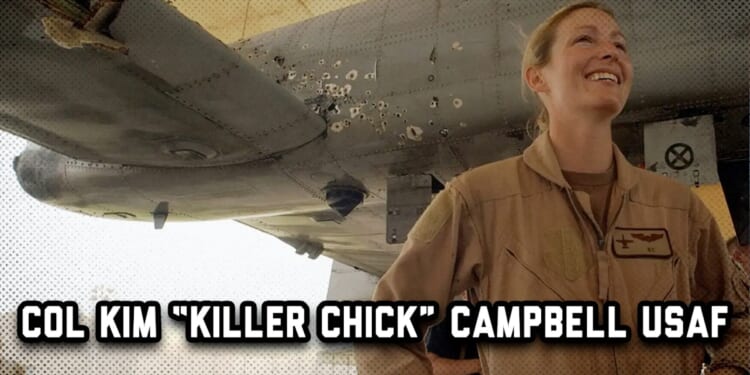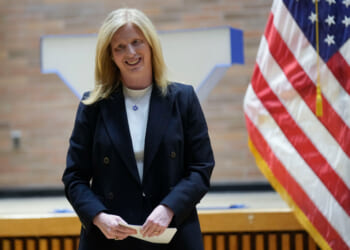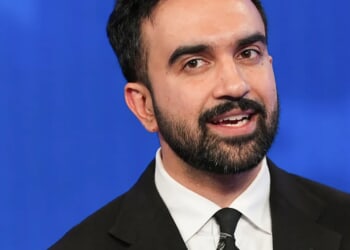Iconic test pilot Chuck Yeager coined this maxim: “If you can walk away from a landing, it’s a good landing. If you can use the airplane the next day, it’s an outstanding landing.”
Colonel Kim “KC” Campbell is a trailblazing Air Force combat fighter pilot who knows something about that maxim.
She is a native of Honolulu, Hawaii, and grew up steeped in aviation interests. Her determination to become a pilot was fixed when she was in fifth grade and witnessed the 1986 televised explosion of the Challenger Space Shuttle. She knew those pilots gave their lives for something bigger than their own self-interest. At age 12, Kim joined the Civil Air Patrol and by 16 had completed her first solo flight.
Pursuing her dream, Kim went to the Air Force Academy, where she distinguished her leadership ability as the cadet wing commander her senior year — the highest rank a USAFA cadet can achieve, and a position her father held a generation earlier. She graduated top of her class in 1997. She earned a fighter pilot billet and excelled as an A-10 Thunderbolt II “Warthog” flight instructor at Pope Air Force Base in Fayetteville, North Carolina. But she knew for sure the 9/11 Islamist attack on our nation would result in combat deployments, and she wanted to be at the front of that line.
In 2003, then-Capt Campbell deployed with her 75th Fighter Squadron to the Middle East in support of Operation Iraqi Freedom. She regularly flew close-air-support (CAS) missions supporting ground troops and aptly demonstrated why her call sign is “Killer Chick.”
As anyone who served in OIF or Operation Enduring Freedom can attest, the sight of an A-10 overhead in combat and the sound of its destructive 30 mm GAU-8 Avenger rotary autocannon was a relief. A relief, I should note, except to the enemy, in whom that site and sound invoked immediate fear.
Of her aircraft, Kim says: “The A-10 is actually fairly easy to fly. It’s all the tactics, techniques, and procedures you have to follow while flying that make things more difficult.”
On 7 April, a few months after deployment, Kim would prove her skills as a pilot when, on a mission out of Ahmad Al-Jaber Air Base, Kuwait, her aircraft was hit with extensive enemy anti-aircraft artillery fire, suffering critical system failures over enemy territory.
Launching in a standard two-ship attack formation with her wingman, Lt Col Rick “Bino” Turner, for a CAS mission in Baghdad, once there, they made several passes over the city before locating their target. Cloud cover forced them to lower altitude, exposing them to AAA fire, and on her final pass, she was hit by a surface-to-air missile.
In her words: “We were originally tasked to target some Iraqi tanks and vehicles in the city that were acting as a command post. But on the way to the target area, we received a call from the ground forward air controller, or FAC, saying they were taking fire and needed immediate assistance. We could see the Iraqi troops firing RPGs, or rocket-propelled grenades, into our guys. It was definitely a high-threat situation, but within minutes, my flight lead was employing his 30 mm Gatling gun on the enemy location.”
She says: “Yes, there was risk involved, but these guys on the ground needed our help. It’s what any A-10 attack pilot would do in response to a troops-in-contact situation. That’s our job; to bring fire down on the enemy when our Army and Marine brothers and sisters request our assistance.”
Then: “We did our job with the guys there on the ground, and we were on our way out when I felt the jet get hit. It was pretty obvious — it was loud… I lost all hydraulics instantaneously, and the jet rolled left and pointed toward the ground, which was an uncomfortable feeling over Baghdad. It didn’t respond to any of my control inputs.”
After attempting several established procedures to regain control of her A-10, she engaged the plane’s manual reversion mode, basically reverting to flight with no electronic or hydraulic assistance. “It was my last chance to try and recover the aircraft, or I would be riding a parachute down into central Baghdad.”
She recalls: “Once I flipped the switch to manual reversion, I don’t remember it being overly difficult. I was just so relieved the airplane was finally climbing and responding.”
Her choice now, still an hour from home base, was to “stay with the jet and try to land it or get to friendly territory and eject.”
She knew that three other pilots had attempted landings using manual reversion, and in one case, the aircraft cartwheeled, killing the pilot. An early report on attempting to fly manually concluded there was “an unacceptable pilot workload for the landing task in the manual reversion mode.”
With additional consultation with her flight leader, she said: “The jet was performing exceptionally well. I had no doubt in my mind I was going to land that airplane. The jet started climbing away from the ground, which was a good feeling because there was no way I wanted to eject over Baghdad.” But she was not out of the fields of AAA: “I couldn’t do much to keep the jet moving, so I was hoping that the theory of ‘big sky, little bullet’ would work in my favor. Amazingly, we made it out of Baghdad and above the clouds with no further battle damage.”
With her full attention on “flying the plane,” her flight leader, Turner, in close formation, provided a visual damage report, observing she had hundreds of holes in the right fuselage tail section and a large hole in her right horizontal stabilizer.
Kim notes that Turner’s actions “after I was hit were absolutely critical” because she “was so focused on flying the airplane, getting it under control, whereas he had more awareness of what was going on around me.”
Determined to save the $45 million aircraft, she performed several pre-landing checklists as emergency ground crew crash teams readied for her landing.
“When you lose all the hydraulics, you don’t have speed brakes, you don’t have brakes, and you don’t have steering,” she said. Despite that fact, she pulled it off. Of her fear on approach, she said, “When I go back and listen to the audio recording [of the flight], I can hear the fear; I just didn’t have time to think about it.”
Once on the ground, a quick walk around the aircraft left Kim and crew amazed it would still fly — but that is one of the reasons this aircraft has remained in our fighter inventory for almost 50 years.
She declared, “I am incredibly thankful to those who designed and built the A-10 as well as the maintainers who did their part to make sure that jet could fly under any circumstances, even after extensive battle damage.”
The next day, Killer Chick was back in the air for a search and rescue mission to find another A-10 pilot who was shot down near Baghdad. She says: “I never really had time to think about the fact that I was going back to Baghdad, where just the day before, I had escaped a possible shoot down. In my mind, the only thing that I could think about was that I had a job to do. I knew that the search and rescue alert crews were there for me the day before, and I was going to do the same for this pilot.”
For her determination to save the aircraft, “KC” was awarded a Distinguished Flying Cross for “heroism or extraordinary achievement while participating in an aerial flight.”
After her first OIF combat tour, she returned for a second deployment providing CAS in both Iraq and Afghanistan.
Following that, she held a succession of distinguished assignments, including becoming an A-10C test pilot at Nellis AFB in Las Vegas, and then as commander for the 612th Theater Operations Group and 474th Air Expeditionary Group at Davis-Monthan AFB. Kim concluded her career at USAFA, serving as the Chair of Airpower Innovation and then as the Director of the Center for Character and Leadership Development. She retired as a full Colonel in 2021.
Over the course of her career, she accumulated 1,800 hours in the A-10, including 375 combat hours during her deployments. Of her legacy: “I never wanted to be labeled as a female fighter pilot. I wanted to be the best pilot. So just work hard and be credible. Be good at what you do.” She added, “The aircraft doesn’t care what our gender is.”
Kim has recounted her career and combat missions in an exceptional interview.
Today, her A-10 is on static display at Seymour Johnson Air Force Base, North Carolina.
Col Kim Campbell: Our nation thanks you for your courage and leadership, putting your life in harm’s way to save others.
(I previously profiled three other exceptional A-10 pilots, Haden, Jay, and Erin Fullam. Brothers Haden and Jay, and Jay’s wife Erin, all served in the same combat squadron.)
“Greater love has no one than this, to lay down one’s life for his friends.” (John 15:13)
Live your life worthy of her sacrifice.
(Read more Profiles of Valor here.)
Semper Vigilans Fortis Paratus et Fidelis
Pro Deo et Libertate — 1776
Follow Mark Alexander on X/Twitter.
Join us in daily prayer for our Patriots in uniform standing in harm’s way in defense of American Liberty, and for the families awaiting their safe return. Pray also for our Veterans, First Responders, and their families.
Please consider a designated gift to support the National Medal of Honor Sustaining Fund’s character education initiatives through Patriot Foundation Trust, or make a check payable to “NMoH Sustaining Fund” and mail it to:
Generosity Trust
National MOH Sustaining Fund
345 Frazier Avenue, Unit 205
Chattanooga TN 37405
Thank you for supporting our nation’s premier journal of American Liberty.
















